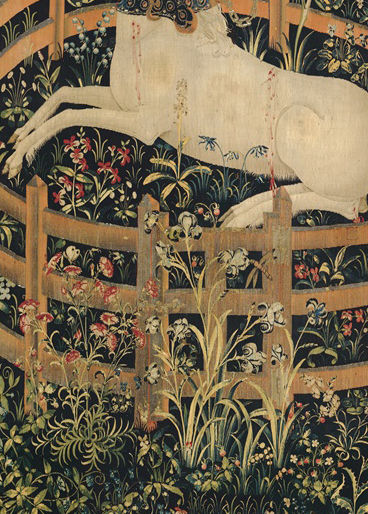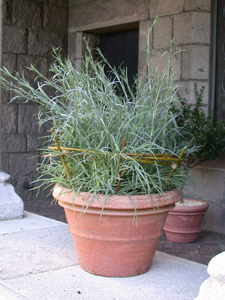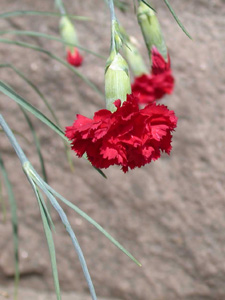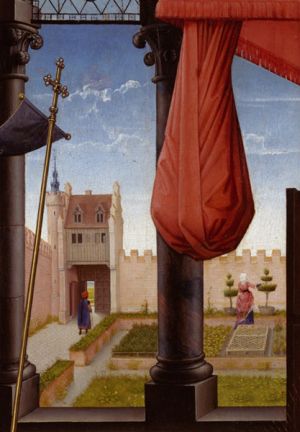The Unicorn in Captivity (from the Unicorn Tapestries) (detail), 1495???1505. South Netherlandish. The Metropolitan Museum of Art, New York, Gift of John D. Rockefeller Jr., 1937 (37.80.6). See Collections to learn more about this work of art. The red-flowered plant that appears to the left of the blue iris, just outside the Unicorn’s enclosure, is a carnation, a doubled garden form of the clove pink. Unlike the iris, which was already of ancient cultivation, these garden pinks were developed in the later Middle Ages.
LUXURIOUS man, to bring his vice in use,
Did after him the world seduce,
And from the fields the flowers and plants allure,
Where Nature was most plain and pure.
He first inclosed within the gardens square
A dead and standing pool of air,
And a more luscious earth for them did knead,
Which stupefied them while it fed.
The pink grew then as double as his mind;
The nutriment did change the kind.
With strange perfumes he did the roses taint;
And flowers themselves were taught to paint.???Andrew Marvell (1621???1678), “The Mower Against Gardens,” Lines 1???12
This complaint, in which a mower laments that the sweet fields have been forsaken for the artificialities of the English Renaissance garden, was penned by Andrew Marvell, the seventeenth-century Metaphysical poet, who wrote as famously and well of gardens and their plants as he did of fields and wildflowers. In “The Mower Against Gardens,” Marvell chooses the doubled pink, or carnation, as the floral emblem of man???s fall from nature and agriculture into horticulture and duplicity. (A reading of the entire poem is available on YouTube.)
The circumstances under which the clove pink (Dianthus caryophyllus) was brought into the gardens of medieval Europe have been much debated. The garden pinks that resulted under cultivation were selected for both semi-double and fully doubled petals, and do not seem to have been known much before 1450. The carnation, as the cultivated form of the wildflower came to be known, was used in both southern and northern European art of the later fifteenth century, in religious and secular contexts, as an emblem of sacred as well as profane love. It was simultaneously a flower of Paradise associated with Christ and the Virgin, and a bridal flower appropriate for betrothal portraits. There are a number of examples in the Museum’s collection, including Bramantino’s Madonna and Child. In Barthell Bruyn the Elder’s sixteenth-century Portrait of a Woman, the doubled carnation has replaced the single pink found in early Netherlandish portraits. (See “Hunting Pinks,” August 9, 2013.)
Left: A modern garden form of clove pink growing in a pot in Bonnefont garden. The carnations known in the fifteenth century, like many of the doubled garden pinks of the sixteenth, seventeenth, and eighteenth centuries, are lost to cultivation. Note the willow support, which is copied from medieval representations. Right: The slender stems of the carnation are too weak to support the weight of the fully doubled flowers, and need to be propped up, as they were in the Middle Ages. Photographs from the Gardens archives.
John Harvey, an authority on medieval gardens and their plants, considers the old red clove pink of the late Middle Ages to be the most modern of all the flowering plants brought into European cultivation before the great age of introductions in the mid-sixteenth century, and surmises that the vogue for the representation of pinks and carnations in late medieval art is coeval with the horticultural development of the flower in the course of the fifteenth and early sixteenth centuries.
Carnations were larger and less cold-hardy than pinks, and were often grown in containers fitted with supports or in beds furnished with latticework frames. These were necessary in order to hold up the now heavy-headed doubled flowers, which could no longer be supported by the plant’s slender stems. The garden viewed through the window of the Virgin’s house in the Annunciation by Hans Memling below has just such a special frame for growing carnations. There is ample evidence for the contemporary horticultural craze for clove pinks, and a lot of trouble was taken to grow them.
Hans Memling (Netherlandish, active by 1465???died 1494). The Annunciation (detail), 1465???75. Oil on wood. The Metropolitan Museum of Art, New York, Gift of J. Pierpont Morgan, 1917 (17.190.7). See Collections to learn more about this work work of art. The enclosed garden viewed through the window of the Virgin’s household has features typical of the late medieval herber, or private garden. A latticework frame for growing carnations can be seen just behind the figure of the woman tending the rosemary topiaries.
The development of the carnation continued unabated for another five centuries. See A Carnation (”Hollandia Liberata”) by Zacharias Blijhooft for an example of an exaggeratedly pinked, fully doubled, striped and speckled Dutch carnation of the seventeenth century. Many named fancy forms of cultivated carnation existed by that date. In England, John Parkinson knew nineteen named forms of carnation, as well as many other garden pinks. By the eighteenth century, there were more than 350 varieties. By the nineteenth century, pinks were exhibited competitively, and professional “pink dressers” prepared them for shows. Many of these varieties, like those of the fifteenth century, are now lost to cultivation, but the Royal Horticultural Society???s Horticultural Database currently lists 230 varieties of this much loved and admired garden flower.
???Deirdre Larkin
SOURCES:
Freeman, Margaret B. The Unicorn Tapestries. New York: E. P. Dutton, Inc., 1956.
Galbally, John with Eileen Galbally. Carnations and Pinks for Garden and Greenhouse: Their True History and Complete Cultivation. Portland, OR: Timber Press, 1997.
Harvey, John H. “Gilliflower and Carnation.” Garden History, Vol. 6, No. 1 (Spring, 1978), pp. 46???5
?????????Medieval Gardens. Beaverton, Oregon: Timber Press, 1981
Hughes, Sophie. Carnations and Pinks: The Complete Guide. Ramsbury, Marlborough, Wiltshire: The Crowood Press, 1991.
Levi D’Ancona, Mirella. The Garden of the Renaissance: Botanical Symbolism in Italian Painting. Firenze: L. S. Olschki, 1977.
Tags: carnation, clove pink, Dianthus caryophyllus, pink





September 11, 2013 at 12:01 pm
Marvell-ous! My mother’s favorite flower, carried them when she wed, I have her pressed example. She received bouquets of them on their wedding anniversary.
I enjoy the information, as usual, but this fond memory inclined me to share.